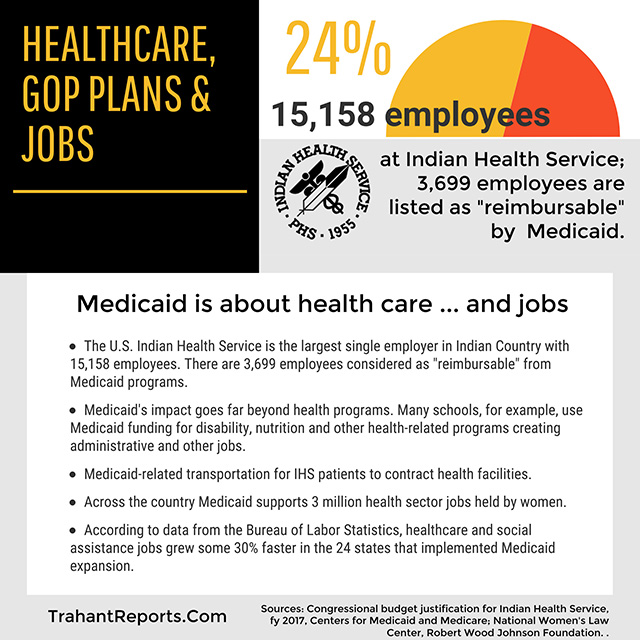
Support justice-driven, accurate and transparent news — make a quick donation to Truthout today!
I am not sure of the exact year. It probably happened around 1996. That’s when the Indian Health Service became the single largest employer in Indian Country.
This makes sense when you think about it: Indian health was once a small (unappreciated) division of the Bureau of Indian Affairs. But by 1996 the agency’s budget was larger than the BIA’s — and there were likely more workers. The administration estimates that next year the BIA will have some 6,770 full-time employees (a decrease of 241) while the Indian Health Service will have more than 15,119 employees (including 1,928 uniformed Public Health Service officers).
Big numbers, right? But that reflects what is happening with health care generally. Google “region’s top employers” and it’s common to see clinics, hospital systems, and university medical centers as any region’s largest employer.
“Employment of healthcare occupations is projected to grow 19 percent from 2014 to 2024, much faster than the average for all occupations, adding about 2.3 million new jobs,” reports the Bureau of Labor Statistics. “Healthcare occupations will add more jobs than any other group of occupations. This growth is expected due to an aging population and because federal health insurance reform should increase the number of individuals who have access to health insurance.”
But here’s the thing: Many of these health care jobs are dismissed as “low wage.” The BLS calls these health care support jobs and the median income (or half pay more and half pay less) as $27,910 which is lower than the median annual wage for all occupations in the economy. The list of support jobs would include Community Health Representatives (long a staple in Indian Country), medical record keeping and coding jobs, as well as different kinds of medical technicians. But what’s considered low wage in the general population, and in cities, can be a good gig in a rural, tribal community.
Alaska is a prime example. More than half of Medicaid spending serves rural constituents, three times more than the national average. Medicaid covers two-thirds of all American Indian and Alaska Native children and more than one in four, or 28%, of American Indian and Alaska Native adults. The Urban Institute estimates that the kind of block grants found in the Senate’s Better Care Reconciliation Act would cost the state $590 million in federal funding — a number that would decline even sharper after 2025. The job losses would be substantial.
This is another reason why the House and Senate plans to roll back the Affordable Care Act (and the destruction of Medicaid as part of the deal) are so important to the Indian health system. The Senate plan especially reverses decades of Medicaid growth. That’s no good for patients (as I have reported before here and here) but it also will cost Indian Country jobs.
Medicaid directly accounts for 24 percent of IHS’ workforce, but even that is short of the kinds of jobs that serve tribal communities. It does not include school-based programs. Or those private companies that bill Medicaid for transportation of patients or other patient services. Same story for jobs that stem from medical coding, accounting and third-party billing services.
Across the country, Medicaid is a major job creator for women, supporting at least 3 million direct jobs. According to a report by the National Women’s Law Center: “When Medicaid pays for a health service — a visit with a health professional, a laboratory test, a hospital stay, a home health visit — this payment supports the facility, agency, or medical practice that delivers the service, and the individuals who provide this care receive compensation as well. Women’s high participation in the health care industry, which employs more than 22.8% of all women in the workforce, means that Medicaid disproportionately creates jobs for women.”
I don’t have a breakdown for these jobs in Indian Country, but from personal experience I would bet the numbers are similar if not higher.
Senate Debate Continues
The Senate, of course, still does not have consensus about a bill to replace the Affordable Care Act. Majority Leader Mitch McConnell suggested last week that Republicans might need to try another direction because “no action is not an alternative.” The Associated Press quoted the senator saying: “If my side is unable to agree on an adequate replacement, then some kind of action with regard to private health insurance markets must occur.” That plan would require votes from Democrats and would likely include a compromise.
Other senators, including Paul Rand, have proposed repealing all of the Affordable Care Act without a replacement, basically putting that off for another day. That would be particularly troubling for Indian Country because a full repeal would likely include the Indian Health Care Improvement Act. But that, too, is complicated by Senate rules. A full repeal would need 60 votes unless that legislation was framed narrowly around budget issues.
But Republican leaders have not given up. The new story they are telling is that 22 million people would “choose” to not carry health insurance. It’s a freedom thing. But that does not square with the destruction of Medicaid. And the jobs that public insurance program has created.
Press freedom is under attack
As Trump cracks down on political speech, independent media is increasingly necessary.
Truthout produces reporting you won’t see in the mainstream: journalism from the frontlines of global conflict, interviews with grassroots movement leaders, high-quality legal analysis and more.
Our work is possible thanks to reader support. Help Truthout catalyze change and social justice — make a tax-deductible monthly or one-time donation today.